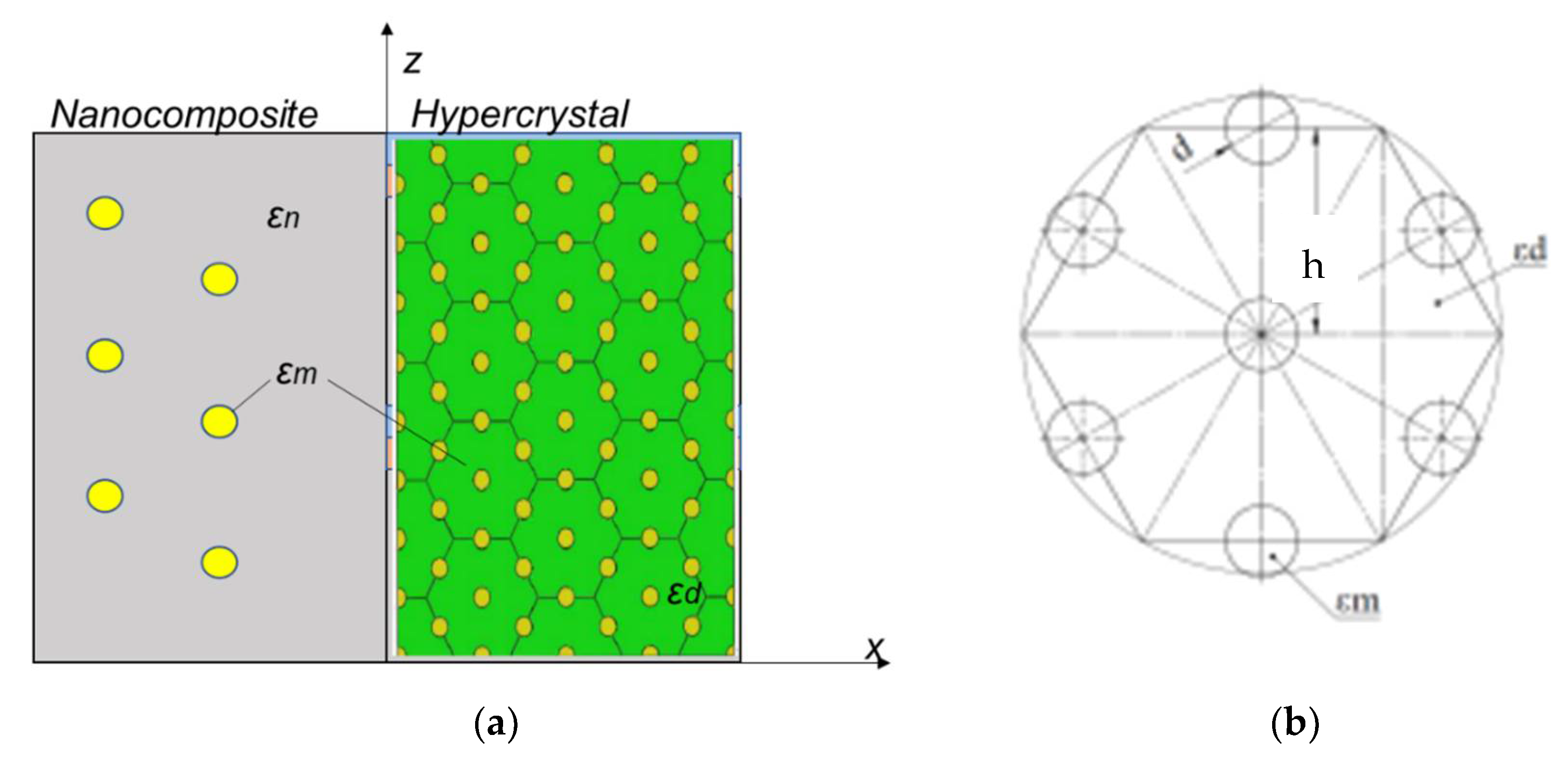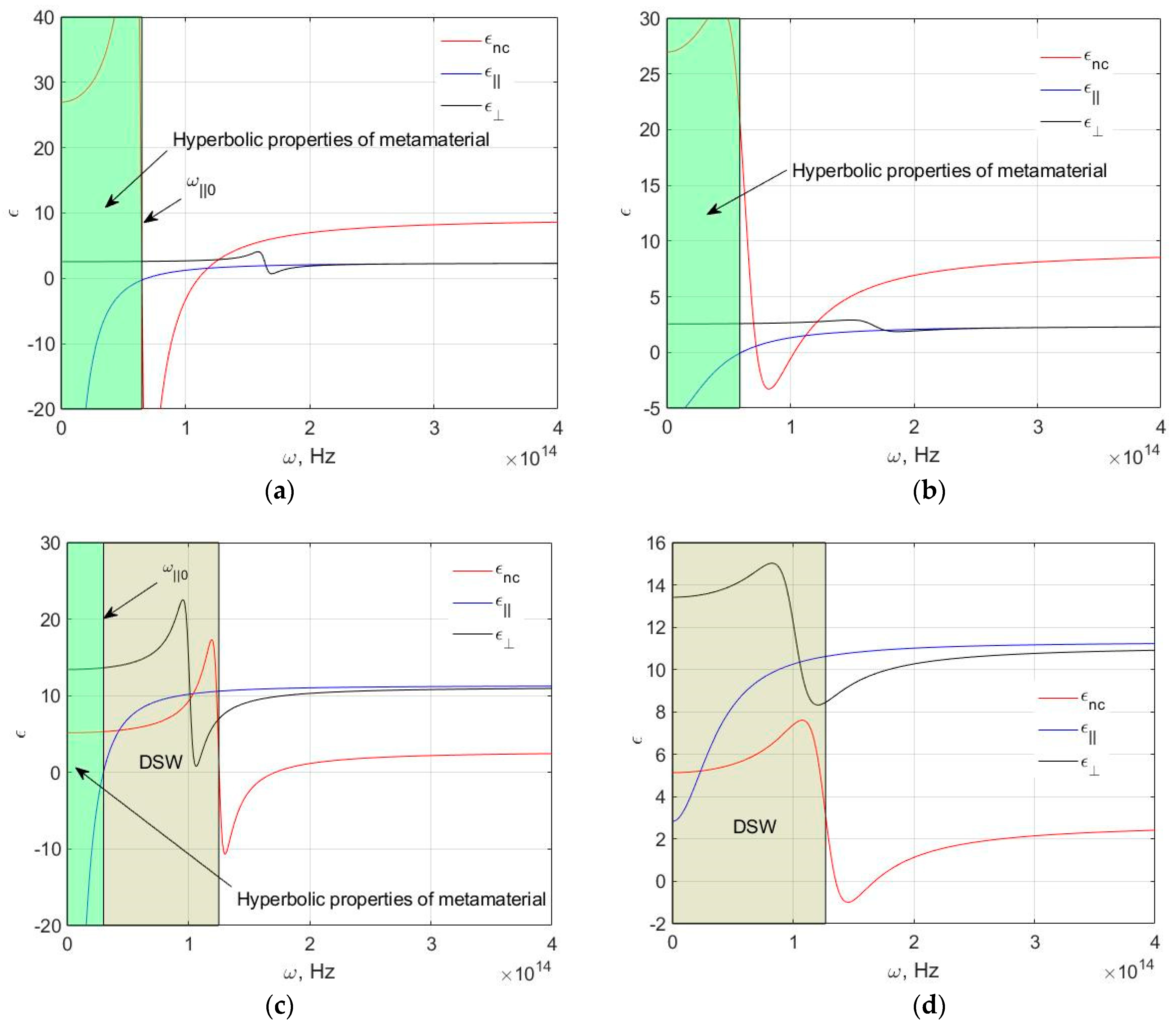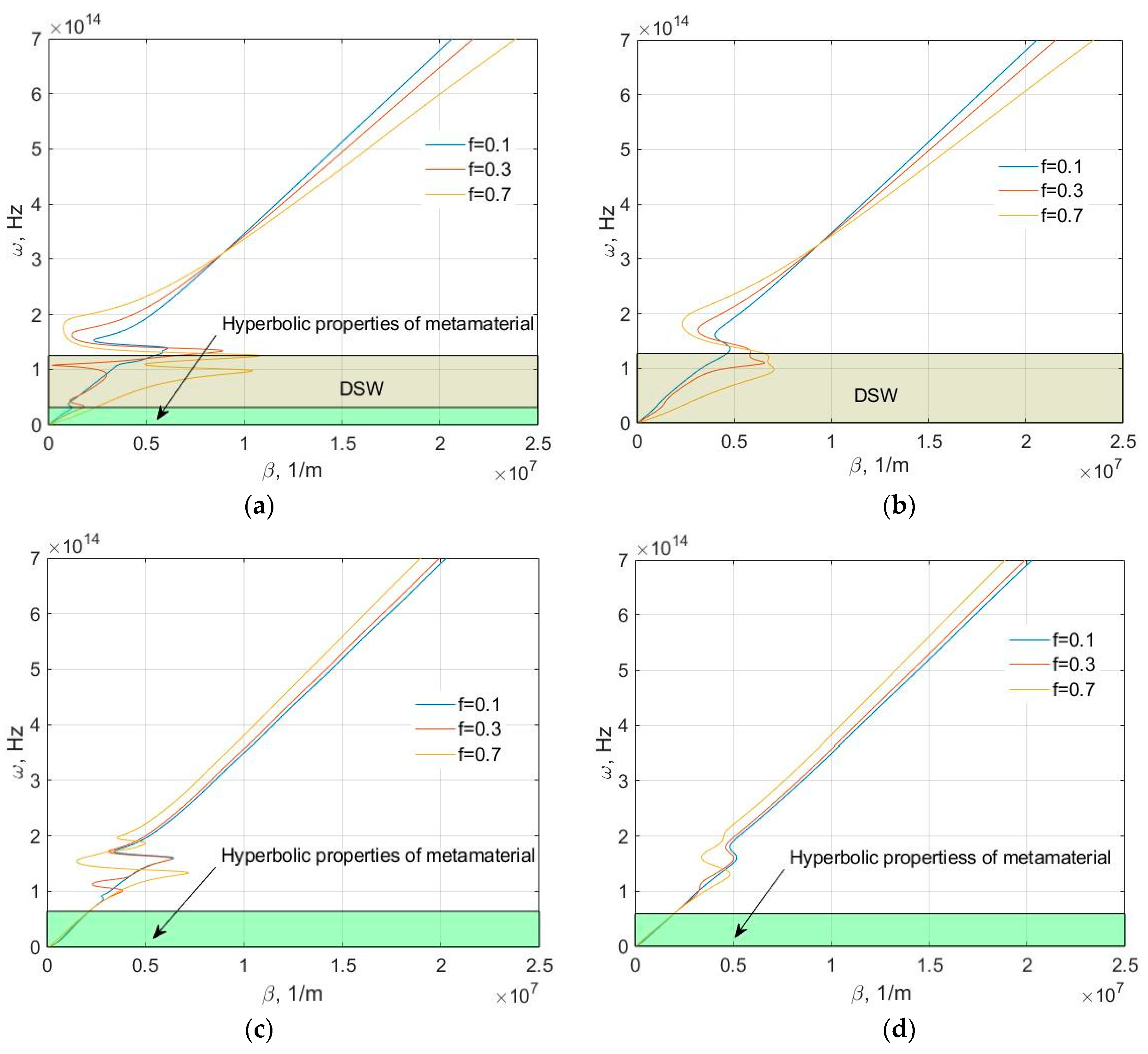Controlling Surface Plasmon Polaritons Propagating at the Boundary of Low-Dimensional Acoustic Metamaterials
Abstract
:1. Introduction
2. Theoretical Approach
3. Results and Discussions
4. Conclusions
Author Contributions
Funding
Institutional Review Board Statement
Informed Consent Statement
Data Availability Statement
Conflicts of Interest
References
- Halperin, W.P. Quantum size effects in metal particles. Rev. Mod. Phys. 1986, 58, 533–606. [Google Scholar] [CrossRef]
- Naik, G.V.; Shalaev, V.M.; Boltasseva, A. Alternative plasmonic materials: Beyond gold and silver. Adv. Mater. 2013, 25, 3264–3294. [Google Scholar] [CrossRef] [PubMed]
- Feigenbaum, E.; Diest, K.; Atwater, H.A. Unity-Order Index Change in Transparent Conducting Oxides at Visible Frequencies. Nano Lett. 2010, 10, 2111–2116. [Google Scholar] [CrossRef]
- Sorger, V.J.; Lanzillotti-Kimura, N.D.; Ma, R.-M.; Zhang, X. Ultracompacy silicon nanophotonic modulator with broadband response. Nanophotonics 2012, 1, 17. [Google Scholar] [CrossRef] [Green Version]
- Cai, W.; White, J.S.; Brongersma, M.L. Compact, High-Speed and Power-Efficient Electrooptic Plasmonic Modulators. Nano Lett. 2009, 9, 4403–4411. [Google Scholar] [CrossRef] [PubMed]
- Das, S.; Salandrino, A.; Wu, J.Z.; Hui, R. Near-infrared electro-optic modulator based on plasmonic graphene. Opt. Lett. 2015, 40, 1516–1519. [Google Scholar] [CrossRef]
- Ye, C.; Khan, S.; Li, Z.R.; Simsek, E.; Sorger, V.J. λ-size ITO and graphene-based electro-optic modulators on SOI. IEEE J. Sel. Top. Quantum Electron. 2014, 20, 40. [Google Scholar]
- Vasudev, A.P.; Kang, J.-H.; Park, J.; Liu, X.; Brongersma, M.L. Electro-optical modulation of a silicon waveguide with an “epsilon-near-zero” material. Opt. Express 2013, 21, 26387. [Google Scholar] [CrossRef]
- Das, S.; Fardad, S.; Kim, I.; Rho, J.; Hui, R.; Salandrino, A. Nanophotonic modal dichroism: Mode-multiplexed modulators. Opt. Lett. 2016, 41, 4394–4397. [Google Scholar] [CrossRef]
- Barnes, W.L.; Dereux, A.; Ebbesen, T.W. Surface plasmon subwavelength optics. Nature 2003, 424, 824–830. [Google Scholar] [CrossRef] [PubMed]
- Zhang, J.; Zhang, L.; Xu, W. Surface plasmon polaritons: Physics and applications. J. Phys. D Appl. Phys. 2012, 45, 113001. [Google Scholar] [CrossRef]
- Peragut, F.; Cerruti, L.; Baranov, A.; Hugonin, J.P.; Taliercio, T.; De Wilde, Y.; Greffet, J.J. Hyperbolic metamaterials and surface plasmon polaritons. Optica 2017, 4, 1409–1415. [Google Scholar] [CrossRef]
- Zhukovsky, S.V.; Andryieuski, A.; Sipe, J.E.; Lavrinenko, A.V. From surface to volume plasmons in hyperbolic metamaterials: General existence conditions for bulk high-k waves in metal-dielectric and graphene-dielectric multilayers. Phys. Rev. B 2014, 90, 155429. [Google Scholar] [CrossRef] [Green Version]
- Mahmoodi, M.; Tavassoli, S.H.; Takayama, O.; Sukham, J.; Malureanu, R.; Lavrinenko, A.V. Existence Conditions of High-k Modes in Finite Hyperbolic Metamaterials. Laser Photon Rev. 2019, 13, 1800253. [Google Scholar] [CrossRef] [Green Version]
- Takayama, O.; Lavrinenko, A. Optics with hyperbolic materials. J. Opt. Soc. Am. B 2019, 36, F38–F48. [Google Scholar] [CrossRef] [Green Version]
- Ferrari, L.; Lu, D.; Lepage, D.; Liu, Z. Enhanced spontaneous emission inside hyperbolic metamaterials. Opt. Express 2014, 22, 4301–4306. [Google Scholar] [CrossRef]
- Hoffman, A.; Alekseyev, L.; Howard, S.; Franz, K.; Wasserman, D.; Podolskiy, V.; Narimanov, E.; Sivco, D.; Gmachl, C. Negative refraction in semiconductor metamaterials. Nat. Mater. 2007, 6, 946–950. [Google Scholar] [CrossRef]
- Feng, J.; Chen, Y.; Blair, J.; Kurt, H.; Hao, R.; Citrin, D.S.; Summers, C.J.; Zhou, Z. Fabrication of annular photonic crystals by atomic layer deposition and sacrificial etching. J. Vac. Sci. Technol. B Microelectron. Nanometer Struct. 2009, 27, 568. [Google Scholar] [CrossRef]
- Shekhar, P.; Atkinson, J.; Jacob, Z. Hyperbolic metamaterials: Fundamentals and applications. Nano Converg. 2014, 1, 1–17. [Google Scholar] [CrossRef] [PubMed] [Green Version]
- Starko-Bowes, R.; Atkinson, J.; Newman, W.; Hu, H.; Kallos, T.; Palikaras, G.; Fedosejevs, R.; Pramanik, S.; Jacob, Z. Optical characterization of epsilon-near-zero, epsilon-near-pole, and hyperbolic response in nanowire metamaterials. J. Opt. Soc. Am. B 2015, 32, 2074–2080. [Google Scholar] [CrossRef] [Green Version]
- Gric, T.; Hess, O. Surface plasmon polaritons at the interface of two nanowire metamaterials. J. Opt. 2017, 19, 085101. [Google Scholar] [CrossRef]
- Iorsh, I.; Orlov, A.; Belov, P.; Kivshar, Y. Interface modes in nanostructured metal-dielectric metamaterials. Appl. Phys. Lett. 2011, 99, 151914. [Google Scholar] [CrossRef] [Green Version]
- Maier, S. Surface Plasmon Polaritons at Metal/Insulator Interfaces. In Plasmonics: Fundamentals and Applications; Springer: New York, NY, USA, 2007. [Google Scholar]
- Gric, T.; Gorodetsky, A.; Trofimov, A.; Rafailov, E.U. Tunable Plasmonic Properties and Absorption Enhancement in Terahertz Photoconductive Antenna Based on Optimized Plasmonic Nanostructures. J. Infrared Millim. Terahertz Waves 2018, 39, 1028–1038. [Google Scholar] [CrossRef]




Publisher’s Note: MDPI stays neutral with regard to jurisdictional claims in published maps and institutional affiliations. |
© 2021 by the authors. Licensee MDPI, Basel, Switzerland. This article is an open access article distributed under the terms and conditions of the Creative Commons Attribution (CC BY) license (https://creativecommons.org/licenses/by/4.0/).
Share and Cite
Ioannidis, T.; Gric, T.; Rafailov, E. Controlling Surface Plasmon Polaritons Propagating at the Boundary of Low-Dimensional Acoustic Metamaterials. Appl. Sci. 2021, 11, 6302. https://doi.org/10.3390/app11146302
Ioannidis T, Gric T, Rafailov E. Controlling Surface Plasmon Polaritons Propagating at the Boundary of Low-Dimensional Acoustic Metamaterials. Applied Sciences. 2021; 11(14):6302. https://doi.org/10.3390/app11146302
Chicago/Turabian StyleIoannidis, Thanos, Tatjana Gric, and Edik Rafailov. 2021. "Controlling Surface Plasmon Polaritons Propagating at the Boundary of Low-Dimensional Acoustic Metamaterials" Applied Sciences 11, no. 14: 6302. https://doi.org/10.3390/app11146302
APA StyleIoannidis, T., Gric, T., & Rafailov, E. (2021). Controlling Surface Plasmon Polaritons Propagating at the Boundary of Low-Dimensional Acoustic Metamaterials. Applied Sciences, 11(14), 6302. https://doi.org/10.3390/app11146302







